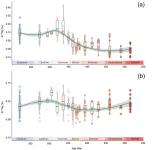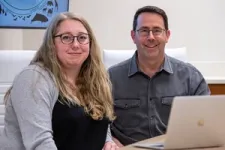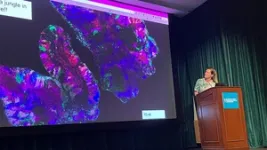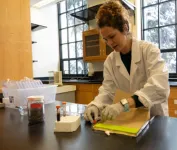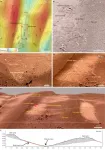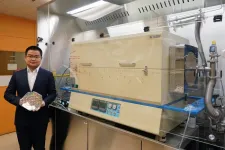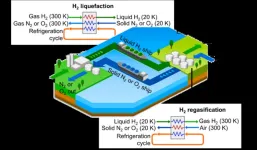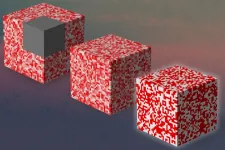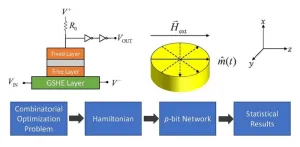(Press-News.org)
The colonization and expansion of plants on land represent a defining landmark for the path of life on Earth. Terrestrial colonization has been attributed to a series of major innovations in plant body plans, anatomy, and biochemistry that transformed global biogeochemical cycles and climates.
It is crucial to identify the onset and track the expansion of those earliest land plants. However, the precise timing of land colonization by vascular plants remains controversial due to the sparseness of early land plant megafossils, poor stratigraphic controls on their distribution, and the uncertainties associated with molecular clock calculations.
Recently, scientists led by Prof. CHEN Daizhao from the Institute of Geology and Geophysics and Prof. FENG Xinbin from the Institute of Geochemistry of the Chinese Academy of Sciences (CAS) used mercury isotope to prove that vascular plants had already extensively colonized land by the early Silurian (~444 Ma).
This work was published in Science Advances on April 28.
Researchers from the Xishuangbanna Tropical Botanical Garden of CAS, the Nanjing Institute of Geology and Palaeontology of CAS, the Chinese Geological Survey, the Open University, UK, and the College of Charleston, USA, were also involved in the study.
Mercury (Hg) is the only heavy metal element that is liquid under natural conditions. It is also transported globally in gaseous elemental form (Hg0) via atmospheric circulation. The most important realization about modern forest Hg cycling in recent decades has been that Hg in vegetation is derived from atmospheric Hg0 assimilation via leaves rather than from precipitation Hg or geologic Hg transport.
Land vegetation preferentially transfers atmospheric Hg0, which displays distinct negative odd mass independent fractionation (odd-MIF, reported as Δ199Hg) and even-MIF (reported as Δ200Hg) signatures, into terrestrial ecosystems. As land plants expanded and affected weathering in terrestrial settings, Hg containing these unique negative Δ199Hg and Δ200Hg values would be transported to nearshore marine environments, which showed significant positive signatures primally. Therefore, the geologic record of these isotopic systems potentially provides a novel tracer to track the colonization and expansion of plants on land.
In this study, the researchers used Hg stable isotope data from marine sediments spanning the Cambrian to Permian from different depositional facies collected from South China to highlight two episodes of distinct negative excursions in both odd- and even-MIF values at the stage level in the Silurian and Carboniferous.
They established a numerical model to quantify secular variations in the contribution from terrestrial organisms for the Paleozoic. They found that the results pushed back in time the extensive spread of early vascular plants to ~444 Ma in the early Silurian, at least in low-latitude areas like South China—a time period that is significantly earlier than the first known macrofossil of a vascular plant.
The study linked the Paleozoic expansion of terrestrial organisms, notably vascular plants, to the co-evolution of a range of earth systems, particularly those of the atmosphere, oceans, weathering processes, and geochemical features.
END
Researchers have figured out a way to predict bacteria’s environmental pH preferences from a quick look at their genomes, using machine learning. Led by experts at the University of Colorado Boulder, the new approach promises to help guide ecological restoration efforts, agriculture, and even the development of health-related probiotics.
“We know that in any environment, there’s a ton of bacteria with important ecological functions, but their environmental preferences often remain unknown,” said Noah Fierer, a fellow of the Cooperative Institute for Research in Environmental ...
The Zhurong rover has found evidence of water on dune surfaces on modern Mars by providing key observational proof of liquid water at low Martian latitudes, according to a study led by Prof. QIN Xiaoguang from the Institute of Geology and Geophysics (IGG) of the Chinese Academy of Sciences (CAS).
The study was published in Science Advances on April 28.
Researchers from the National Astronomical Observatories of CAS and the Institute of Atmospheric Physics of CAS were also involved in the study.
Previous ...
Vallia Antoniou, an assistant professor of practice in the Department of Physics and Astronomy at Texas Tech, has been awarded observing time on the powerful Chandra X-Ray Telescope to explore some of the deepest recesses of the universe.
It marks the second major Chandra program led by Antoniou, who is also a research associate with the Smithsonian Astrophysical Observatory.
Each year, astronomers from around the world follow a rigorously competitive process to receive Chandra time. The telescope was launched aboard the space shuttle Columbia in 1999 and orbits Earth, offering previously unavailable views of deep space at wavelengths that are not accessible from ground telescopes. During ...
CAMBRIDGE, MA — Emerging AI applications, like chatbots that generate natural human language, demand denser, more powerful computer chips. But semiconductor chips are traditionally made with bulk materials, which are boxy 3D structures, so stacking multiple layers of transistors to create denser integrations is very difficult.
However, semiconductor transistors made from ultrathin 2D materials, each only about three atoms in thickness, could be stacked up to create more powerful chips. To this end, MIT researchers have now demonstrated a novel technology that can effectively ...
The green hydrogen economy is a sustainable alternative to fossil fuels. However, one of the challenges of constructing a global hydrogen economy is hydrogen transportation by sea. A new paper proposes solid air as a medium for recycling cold energy across the hydrogen liquefaction supply chain.
The world is undergoing an energy transition to reduce CO2 emissions and mitigate climate change. The COVID-19 pandemic and the Russia-Ukraine war have further increased the interest of Europe and Western countries to invest in the hydrogen economy as an alternative to fossil fuels. Hydrogen can significantly reduce geopolitical risks ...
CAMBRIDGE, MA — Maybe you can’t tell a book from its cover, but according to researchers at MIT you may now be able to do the equivalent for materials of all sorts, from an airplane part to a medical implant. Their new approach allows engineers to figure out what’s going on inside simply by observing properties of the material’s surface.
The team used a type of machine learning known as deep learning to compare a large set of simulated data about materials’ external force fields and the corresponding internal structure, and used that to generate a ...
According to computational complexity theory, mathematical problems have different levels of difficulty in the context of their solvability. While a classical computer can solve some problems (P) in polynomial time — i.e., the time required for solving P is a polynomial function of the input size — it often fails to solve NP problems that scale exponentially with the problem size and thus cannot be solved in polynomial time. Classical computers based on semiconductor devices are, therefore, inadequate ...
TORONTO, April 28, 2023 — Is an equitable world that includes humans and machines possible? York University researchers believe it must be and have set out to make it so through a first of its kind interdisciplinary research initiative called Connected Minds: Neural and Machine Systems for a Healthy, Just Society.
From universities to industries, hospitals and policymakers, artists and Indigenous communities, York’s Connected Minds will engage 50+ community partners and research collaborators over seven years supported by a historic $318.4 million in funding. Connected Minds has received a combined $105.7 million from the Canada First Research ...
Betting on tailless sperm that evolved from brave swimmers to hapless floaters seems like a crazy evolutionary gamble, but a group of fish seems to have done just that. Understanding that tradeoff holds promise to shed light on human disease and shake up biology lessons on traditional gender roles.
Michigan State University associate professor of integrative biology Jason Gallant and colleagues are using nearly $1 million from the National Science Foundation to understand the implications from a small African fish which ...
Alex Zhavoronkov, PhD, founder and CEO of Insilico Medicine (“Insilico”) will present at the 9th LSX World Congress happening in London May 3 and May 4. Zhavoronkov, an expert in generative artificial intelligence (AI) for drug discovery, will present on May 3, 2:45pm (London time) on “‘Death By Pilot’” to Asset Licensing – the Evolution of Pharma-AIDD Partnerships” as part of the Biotech Growth CEO Forum and on May 4, 9:30am (London time) on “Building a Galvanizing ...
